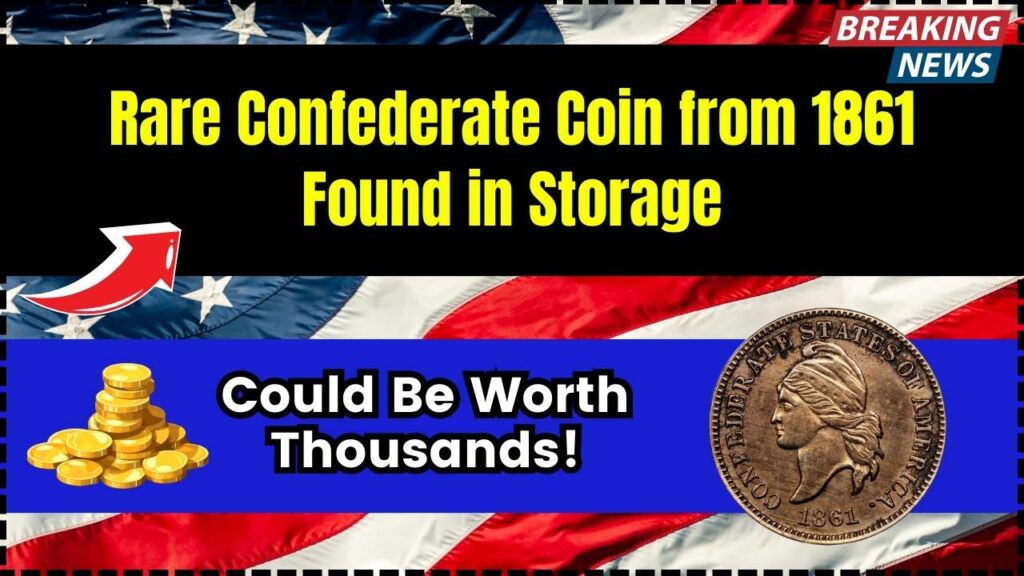Rare Confederate Coin from 1861 Found in Storage: Imagine rummaging through an old attic or dusty garage and stumbling upon a mysterious coin nestled among old papers and forgotten treasures. To most people, it might seem like a rusty relic—but for those who know what to look for, this coin could be a window into one of the most dramatic chapters in American history. That’s precisely what happened recently when an incredibly rare 1861 Confederate coin was found in a long-forgotten storage box. Experts say it could be worth thousands, and in some cases, up to a million dollars, depending on the type and condition.

Coins like this are far more than just metal disks. They are historical artifacts minted during the chaos of the Civil War, when the Confederate States of America (CSA) briefly tried to establish its own economy. These rare pieces are highly valuable not only because of their age and scarcity but because they encapsulate a period of turmoil, rebellion, and dramatic change in the United States.
Rare Confederate Coin from 1861 Found in Storage
| Feature | Details |
|---|---|
| Coin Type | 1861 Confederate Cent or Half Dollar |
| Historical Context | Issued by the Confederate States of America during the Civil War |
| Rarity | Only 4 original Half Dollars and 16 original Cents known to exist |
| Estimated Value | $50,000 to $960,000 (depending on condition and type) |
| Authentication Services | NGC, PCGS |
| Auction Record | $960,000 (Eric P. Newman Collection, 2017) |
| Official Resource | Smithsonian Institution |
The rediscovery of a rare 1861 Confederate coin is more than just a financial windfall—it’s a deeply personal connection to America’s turbulent past. For those lucky enough to find one, it’s like holding a time capsule from the Civil War in the palm of your hand. Whether you’re a seasoned collector, an amateur historian, or just someone curious about what treasures might be hiding in the attic, knowing how to identify, verify, and protect these coins can lead to a rewarding journey through history.
The Fascinating History of Confederate Coins
In 1861, the United States was on the brink of division. As eleven southern states broke away to form the Confederacy, they needed everything from uniforms to postage stamps—and yes, even their own money. One of their boldest moves was taking control of the New Orleans Mint, where they struck a very small number of coins before the war intensified and resources dwindled.
Confederate Half Dollar
Only four original Confederate half dollars were ever made. These ultra-rare coins were struck using a U.S. Seated Liberty design on the front and a unique Confederate emblem on the back. The project was quickly abandoned due to the war’s escalation, and the coins disappeared into private collections. One such coin resurfaced in 2017 and sold for an astonishing $960,000, a record-setting moment in the numismatic world (CoinWorld).
Confederate Cent
The Confederate one-cent coin was a private endeavor by engraver Robert Lovett Jr. in Philadelphia. He crafted around 16 original pieces but halted production after fearing legal consequences from the Union government. Despite their limited number, these coins offer a glimpse into the Confederate ambition for economic autonomy. One of these original cents fetched $186,000 at auction (Heritage Auctions).
Restrikes and Replicas
Many copies of Confederate coins were later minted as commemorative pieces or restrikes. While not as valuable as originals, they can still hold substantial worth, especially if officially sanctioned, such as those authorized by the Smithsonian Institution in recent years.
Identify a Genuine Confederate Coin
Given how few original Confederate coins exist, the market is flooded with replicas. If you believe you’ve found one, proceed carefully. Proper authentication is key. Here’s how to identify if your coin is the real deal:
1. Design Details
- Half Dollar: Features a Confederate shield and inscriptions like “Confederate States of America” on the reverse.
- Cent: Has a profile of Liberty on the front and a plain “1 CENT” on the back, with no country name.
2. Minting Characteristics
Real Confederate coins often show signs of manual striking or age, like uneven edges, natural toning, or die imperfections. Reproductions may be too uniform or shiny.
3. Seek Professional Grading and Authentication
Submit your coin to one of these respected services:
- NGC (Numismatic Guaranty Company)
- PCGS (Professional Coin Grading Service)
These experts will analyze the coin’s metal content, design, condition, and origin, then encapsulate it in a tamper-proof holder.
4. Review Provenance and Ownership History
Coins with known origins, especially those linked to famous collections, are far more valuable.
Why Are Confederate Coins So Valuable?
These coins command high prices not just because they’re old, but because they are:
- Historically significant: Tied directly to the Confederate cause and the Civil War.
- Exceptionally rare: Fewer than 25 known originals exist.
- Highly sought after: Desired by collectors, historians, and even museums.
- Well-documented: Coins with provenance and grading tend to fetch exponentially higher prices.
For example, a Confederate cent in mint condition with proper authentication could easily reach six figures at auction. Add historical context or celebrity ownership, and that value could soar even higher.
What to Do If You Think You’ve Found One
Think you’ve hit the jackpot with a Confederate coin? Here’s a step-by-step guide to make sure you handle it correctly:
- Avoid Cleaning or Altering the Coin: Cleaning might remove original patina or cause scratches, which dramatically reduces value.
- Document Its Features: Photograph both sides, note any visible inscriptions, and write down where and how it was found. All these details help experts determine authenticity.
- Consult a Local or Online Numismatist: Reach out to professional organizations like the American Numismatic Association (ANA) or visit local coin shops with good reputations.
- Submit to a Grading Service: Send your coin to NGC or PCGS for official grading and encapsulation.
- Explore Auction Options: Once verified, connect with top auction houses like Heritage Auctions or Stack’s Bowers to assess value and market demand.
- Consider Insurance and Storage: If your coin turns out to be valuable, get it appraised for insurance and store it in a secure, climate-controlled environment.
Lincoln Wheat Penny Worth $4.2 Million — Have You Checked Your Coins Yet?
1777 George III Five Guinea Coin Worth $340,000: Do You Own One?
These 7 Rare $2 Bills Could Be Worth Thousands in 2025 – Do You Have One?
FAQs On Rare Confederate Coin from 1861 Found in Storage
Q1: How do I know if my Confederate coin is real?
A: Always check with a professional grading service like NGC or PCGS. Look for signs of authentic minting, historical wear, and proper design elements.
Q2: Are modern reproductions worthless?
A: Not necessarily. Some restrikes and commemoratives, especially official ones, can still be worth hundreds or thousands of dollars depending on demand and condition.
Q3: Can a damaged Confederate coin still have value?
A: Yes. Even if a coin is worn or partially damaged, it may still be valuable due to rarity. However, condition will affect the final price.
Q4: What metals were used in original Confederate coins?
A: Originals were made from copper-nickel (cents) and silver (half dollars). Any unusual metal could indicate a replica.
Q5: Where can I learn more about Civil War-era currency?
A: Trusted educational resources include the Smithsonian Institution, American Numismatic Association, NGC Coin News and PCGS CoinFacts.








